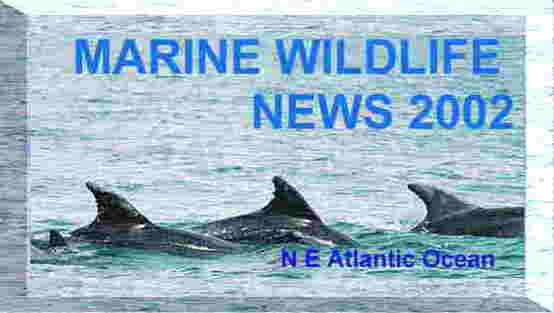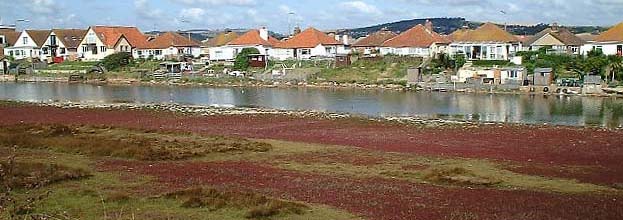
|
|
|
|
|
(BMLSS *** Site) |
|
|
|
Norwegian Marine*** |
|
L-I-N-K-S to Other Sites (Click on Text) |
|
How to Join |
|
|
|
|
|
Recommended Sites |
|
|
|
|
|
|

Monthly Marine News Bulletin |
|
Marine Nature Conservation Review Survey Database |
|
|
 |
|
|
|
|
|
|
Reports of marine wildlife from all around the British Isles, with pollution incidents and conservation initiatives as they affect the fauna and flora of the NE Atlantic Ocean.
on Microsoft Internet Explorer (best) or Netscape
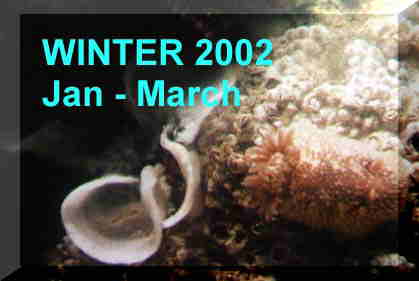 |
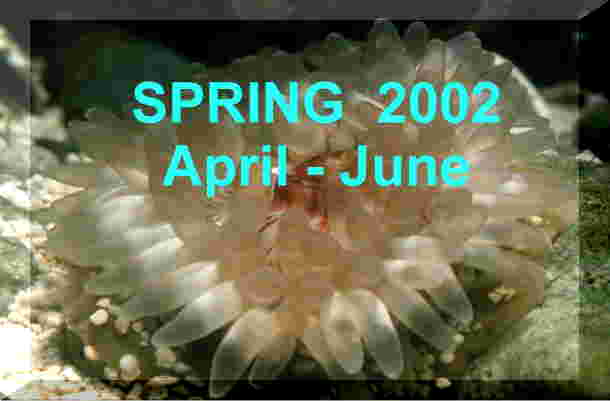 |
 |
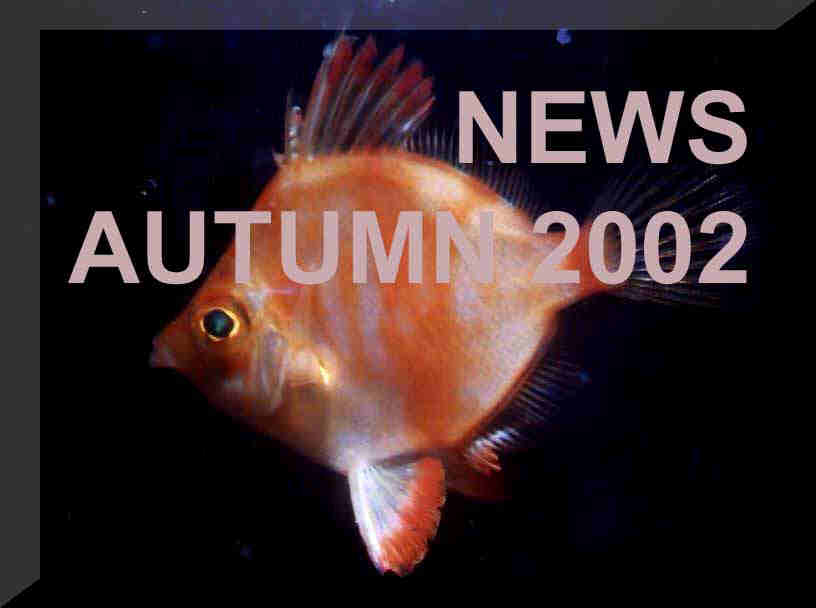 |
- LATEST
NEWS
- 23
September 2002
A Silver Dory (=Sailfin Dory), Zenopsis conchifer, is trawled six miles off Wolf Rock, Cornwall. This is such an unusual occurrence that the fish is not in the popular British list of marine species. This fish was 38 cm long and weighed 550 grams, gutted.
It
could be mistaken for similar John Dory,
Zeus
faber. The Silver Dory is the complete fish shown in the photograph
of the fish caught and preserved and the upper fish is a John Dory. The
John Dory inhabits shallow water but the new fish is a denizen of the deep.
It is widespread in tropical seas where it sometimes enters shallow waters.
There has been a handful of previous records off Cornwall, the first official
one recorded on 29 August 1995.
Previous
Records
from help from Paul Gainey and notes by Stella Turk
Previous Records from the Geoff Potts and Swaby British Fish Records
18
September 2002
A Flying
Gurnard, Dactylopterus volitans,
was caught in a scallop dredge by the F.V.
Natalie B, skipper Steven Frank Hatton, out
of Newlyn, Cornwall, in 70 metres of water 9.7 miles east of Wolf Rock
off the south-west coast of Cornwall. It is only the second specimen of
this tropical fish caught in the seas around Britain. The previous fish
was also caught off Cornwall.
It
was described by Robin Turner (Newlyn)
as about 30 cm (1 foot) long with large scales and a colour olive green
flecked with brown, small ventral mouth, two large spikes pointing down
its back and two bony protrusions from its jowls. The pectoral (side) fins
were very large.
It
is not actually a gurnard although it looks very similar: it belongs to
the Order Dactylopteriformes, family Dactylopteridae (gurnards are Scorpaeniformes,
family Triglidae).
via the Marine Wildlife of the North-east Atlantic Ocean Group
A
bright
orange starfish, Echinaster sepositus,
was caught in a bottom gill net near the south-west corner of Guernsey
in over 30 metres of water. The fisherman, Ken
Robilliard, who caught it and has fished for
25 years says he had never seen this species before.
BMLSS Starfish
c.
11 September 2002
A Bearded
Seal, Erignathus barbatus, was found near Leenane (the entrance
is Killary harbour), in south County Mayo, on the west coast of Ireland.
This is the first record of this Arctic seal for Ireland.
beside the bridge in Leenuan, (53° 60'N, 9° 50'W) calmly watching the children go to school. She is 1.5 meters in length, close to 60 kg (best estimate).
11
September 2002
Between
the 4 September and 10 September, 209
dead
Common Seals, Phoca vitulina, were
reported around the UK bringing the total to 1005 since the beginning of
the Phocine Distemper Virus outbreak.
890 of these were from around the coast of England, predominantly from
the Norfolk coast with smaller numbers reported from Suffolk, Lincolnshire,
Northumbria and the East Riding of Yorkshire.
Phocine Distemper Virus among European Seals 2002
BMLSS Seal News
Bottle-nosed Dolphins, Tursiops truncatus, put on the show for visitors, in Fistral Bay, Newquay, Cornwall, with between 8 and 10 dolphins shooting along on the waves with the surfers and leaping out of the water, all this was set in front of a beautiful sunset.
About
six miles out of Whitby, Yorkshire, we had two sightings of Minke
Whale, Balaenoptera acutorostrata,
which I believe were two separate individuals. However on the way back,
again NNE from port and six miles out between about 17.00 and 17.30, we
saw at least five Minke Whales with four in view at one time. We also saw
at least twenty small pods of Harbour Porpoises,
Phocoena
phocoena, with two to five individuals a pod.
6-8
September 2002
6th
Annual EEA (European Elasmobranch Association) meeting
Shark
Trust
28
August 2002
Helen
Selvey of Polzeath Voluntary Marine Wildlife Area,
has found those miniature 'green-eyed monsters' for which Paul
Gainey has been seeking as he would like to
photograph them. When she placed a large freshly dead Root-mouth
Jellyfish, Rhizostoma
octopus in a vessel of seawater, from under it swam a few dozen
specimens of a small 12 mm amphipod crustacean
called Hyperia
galba. They are always associated
with one or other of the species of jellyfish,
living under the shelter of the umbrella (often within the gonad cavities)
where they are sought by some species of fish.
There
are only three records on the species database for Cornwall, the latest
being 1928 with a 'Plymouth area' record for 1953. Of course not
many people would look for them, but the influx of jellyfish represents
a good opportunity - so
please 'phone me on 01209 712069 if
you find any and can keep them alive in a container in a cool place.
From
the Palace Pier, Brighton, we saw two jellyfish
moving very slowly. They were very large we estimated them to be about
130 cm (4-5 feet)? in a diameter, a large white dome, medusa with a dark
rim, with strange white panel type of things below and then short pale
blue tentacles. This is the species Rhizostoma
octopus. This species has been very common this year.
NB.
this size may be overestimated.
28 August 2002
La Société Guernesiaise Cetacean Section Report
As many as 20 Long-finned Pilot Whales, Globicephala melas, are reported by Channel Television's Nicky Bougourd and team off Fermain, on Guernsey's south-east coast (Channel Islands, English Channel). The animals which included juveniles were observed between 9:30 am and 10:30 am following a tip-off from Deputy Harbour Master Tony Pattimore who had spotted them on the Search and Rescue CCTV. The result was some stunning film of these magnificent creatures, which are believed to be possibly on migration as they are normally seen in July, August or September. However sightings are confined to 2-3 per annum and this one was exceptional due to the number of animals observed. Nicky Bougourd saw 12 animals, around 6 metres in length. Some of them were smaller juveniles. The pilot whales rested motionless at times, and then dived down for periods. They were not feeding according to the crew. Their usual diet is cephalopods, including squids.
There was a smaller group also observed at 10:30 am for 20 minutes off St.Martin's Point of about 6 animals together with some smaller dolphins by Ron Wilton, Ellen Wood and family aboard the "Selika". These could have well been part of the same group. The Herm Travel Trident also observed the Pilot Whales in the Little Russel, between St. Peter Port, Guernsey and the island of Herm.
Reporters: Nicky Bougourd CTV, Ellen Wood, Tony Rive and Tony Pattimore.
Original report and excellent footage shown on "Channel Television" BBC Southwest. La Société Guernesiaise Sightings Web Pages
BMLSS Cetacea
 Late
August 2002
Late
August 2002
Three
specimens of the
Short-snouted
Seahorse,
Hippocampus
hippocampus,
were discovered about 95 miles east of the Solent in the English Channel.
They were picked up during DEFRA sponsored fish habitat studies by
the University of Wales Bangor research vessel Prince Madog.
Each came up in separate gear deployments, though at a single sampling
station. On UWTV the benthic biotope where they came from was seen to be
sand with a dense bed of tube worms, Lanice conchilega. All three
seahorses were "pregnant" males.
22
August 2002
Up
to five Minke
Whales, Balaenoptera acutorostrata,
are seen between Mallaig and the Isle of Eigg (west Scotland) and one adult
whale was breaching one mile off the Isle of Rum. This Minke
was reported twisting during at least one of the twenty breaches, leaving
the water completely at times. A breaching Minke
Whale was seen in subsequent days north west
of the Garvellachs near Oban.
21
August 2002
Hundreds
of dead decomposing Salmon, Salmo
salar, force the closure of Loch Erisort
on the Isle of Lewis in the Outer Hebrides. The salmon in the nets were
first killed by thousands of jellyfish and then the dead weight of fish
broke the net and the recovery of hundreds of the dead fish was missed.
21
August 2002
A
pod of 20 Risso's Dolphins, Grampus griseus, passed through
Bluemull Sound, betwen Unst and Yell in the Shetland Isles.
20
August 2002
Fishermen
'thousands' of jellyfish in Port Isaac Bay, Cornwall, in the third week
of August: some were dark blue and others were brown. Malcolm
Lee reported 42 Compass
Jellyfish, Chrysaora hysoscella,
and 54 Blue Jellyfish, Cyanea lamarcki, trapped in the narrow
Port Gaverne Cove, Cornwall. (SX 00 80).
14
August 2002
Henry
Altenberg saw a large Leatherback
Turtle, Dermochelys coriacea,
over 2 metres in length, six miles off Coverack, Cornwall. It was attacking
a large jellyfish, Rhizostoma
octopus, which it pushed to the surface and threw in
the air with a quick flick whilst grabbing a mouthful of 'jelly flesh'.
13
August 2002
Tests
on dead Common
Seals, Phoca vitulina, found on
carcasses from the coast of Lincolnshire and Norfolk have confirmed they
died from the Phocine
Distemper Virus. The British outbreak
was confirmed by the RSPCA after five dead seals, including three pups,
were found around the Wash.
13
August 2002
One
large Octopus vulgaris was caught south of Plymouth and landed
on the Plymouth Fish Market.
via the Marine Wildlife of the North-east Atlantic Ocean Group
12
August 2002
An 11.5
metre long Humpback
Whale, Megaptera
novaengliae, was seen close to the shoreline in shallow water near
Banff in the Moray Firth, Scotland by the Cetacean
Research & Rescue Unit. The whale is believed to be a female and
possibly one of the west Greenland animals. Three weeks earlier (24
July 2003) a Humpback Whale was seen at the
same location. This is the first evidence of this species in the Moray
Firth in recent years.
7 August 2002
An invasion of tiny (12-15 mm) jellyfish has killed about 900 thousand Salmon at two fish farms in Loch Erisort on the Isle of Lewis in the Outer Hebrides. The offending deadly organism travelling like large 15 metre deep clouds through the sea have been identified as the narcomedusan Solmaris corona, and also identified three other hydromedusans that were abundant in the blooms as Phialidium, Leuckartiara octona and Catablema vesicarium.
These oceanic species will not be listed in the popular guides. The Narcomedusae are gelatinous hydrozoans, abundant at depths between 100 and 1000 metres, an area known as the midwater. These rarely seen jellyfish are most easily recognized by the unique location of their primary tentacles. Unlike other jellyfish, the tentacles of the Narcomedusae originate well above the bell margin. These tentacles are often held in front of the jellyfish as it swims through the midwater. They feed on zooplankton.
They have been recorded in the north-eastern Atlantic Ocean but they are rarely mentioned. Solmaris
Narcomedusae
6 August
2002
Ian
McConnell reported
seven White-beaked Dolphins, Lagenorhynchus albirostris,
about 1.5 km east of Norwick (Unst) in the Shetland Isles.
30
July 2002
Over
the past five weeks during shore surveys on the west coast of Scotland,
two specimens of the Blue Jellyfish,
Cyanea
lamarcki were seen: in the Sound of Jura and near Loch Ewe in Wester
Ross. Both were under 10 cm in diameter and a vivid blue. Today, a report
reached me of a diver who was stung on the wrist off the island of Canna,
probably by this species, and spent two and a half painful days in hospital.
This species is much more unpleasant than the common reddish-brown Lion's
Mane Jellyfish, Cyanea capillata and
seems to be much less common.
Jellyfish Stings
29-30
July 2002
The
Daisy
Anemone,
Cereus
pedunculatus, has been discovered by Paul
Parsons off the outfall pipe near Brooklands boating lake east Worthing,
West Sussex.. I (Andy Horton) have discovered this
sea anemone (that contains symbiotic
algae) on Worthing beach on one memorable occasion,
but at the moment this seems the most easterly discovery of this sea
anemone on the northern English Channel coast and shallow seas.
BMLSS
Sea Anemones
Adur
Nature Notes
27
- 28 July 2002
National
Whale and Dolphin Watch Weekend
http://www.seawatchfoundation.org.uk/events.htm
Click
here for full details of the National Whale and Dolphin Watching Weekend
and how you can get involved.
The Sea Watch Foundation are inviting you to take part in the UK's first ever National Whale and Dolphin Watch Weekend, aimed at providing a snapshot picture of the numbers and variety of whales, dolphins and porpoises to be seen around the British Isles.

Bottle-nosed Dolphin "George"
Photograph by Steve Trewhella
A little
over 200 sites were manned around the British Isles including Northern
Ireland, from Hermaness in Shetland down to Jersey in the Channel Islands
and Isles of Scilly in Cornwall. Around one thousand people participated,
with
groups of as many as 20-30
attending
some sites. Systematic watches were carried out from the land-based sites
whilst others went to see on a variety of vessels from yachts to oil rig
supply vessels and ferries. The prime aim was simply to raise public awareness
of whales and dolphins around the British Isles, although we also hoped
it would provide a useful 'snapshot' of the coastal distribution of different
species in late July.
UK Dolphin Watch Image Portfolio, July 2002
Late
July 2002
A
large number of jellyfish
are washed up on the beach at Gwithian Towans near Hayle, Cornwall. There
were three different types but have been unable to identify them. One was
clear with tentacles and ranged in size from small to very large (bigger
than a football), another was ball sized with tentacles and brownish colour
to the main body and the other type was fist sized, no long tentacles and
blue in colour.
Barrel Jellyfish Rhizostoma octopus (=R. pulmo)
Lionís Mane Jellyfish Cyanea capillata
By-the Wind Sailor Velella velella
July
2002
Tadpole
Fish, Raniceps raninus,
are being caught by anglers off Mevagissey Quay, Cornwall. Some of them
are on display at Mevagissey Harbour Marine
Aquarium where they tend to hide away rather a lot and it is only the
expert visitor that can see them.
19
July 2002
42
Rhizostoma
octopus, Root-mouth Jellyfish,
carefully counted, were on the shore at Polkerris near Par, Cornwall, with
50 in the shallows. About the same time 30 were on Par Beach.
These
were the top numbers beached, but elsewhere they were in up to ten on many
Cornish shores. Offshore they were in large shoals but
less easy to count. But more that one person said they are present this
year 'in hundreds if not thousands'.
16
July 2002
A
pod of twenty
Common Dolphins, Delphinus delphis,
and
three Porpoises,
Phocoena
phocoena, were spotted by Paul Semmens
off Kenidjack, Cornwall (SW 3632).
9
July 2002
The
miniature sea anemones discovered in Widewater Lagoon,
Lancing, were identified as dwarf specimens of the distinctive Haliplanella
lineata with orange stripes which are not found on other British
sea
anemones. The anemone photographed was only 2 mm in height and 3 mm
in diameter and this was typical of the dozen anemones discovered in two
locations each side of the bridge.
7 July
2002
A badly
decomposed Cuvier's Beaked Whale,
Ziphius
cavirostris, was washed up on Gwynver Beach, Whitsand Bay, Cornwall
(SW
362275). It was about 5 metres long.
4 July
2002
Three
Leatherback
Turtles, Dermochelys coriacea,
were found on three separate Cornish beaches alive at Millook Haven, 6
km south of Bude on the north coast, and Perran Sands (SW
7655), with a dead specimen washed up at on
the strandline of Watergate Bay, Cornwall.
EuroTurtle
The Marine Conservation Society have produced a laminated Turtle Advice Sheet (endorsed by DEFRA). The guide contains reports numbers and advice.
Public Exhibition of the Lancing rocky Sea Defence Plan on the seaward side of Widewater Lagoon, Lancing, West Sussex. The most controversial proposal seems to the the inclusion of a seawater pipeline.
A miniature sea anemone has been discovered in Widewater, and identified as a dwarf specimen of the distinctive Haliplanella lineata with orange stripes which are not found on other British sea anemones. The anemone photographed was only 2 mm in height and 3 mm in diameter and this was typical of the few anemones discovered.
3 July
2002
A
very badly decomposed and smelly Sperm
Whale, Physeter catodon, is washed
up at the beach at historic Hopetoun House near South Queensferry on the
Firth of Forth, east Scotland. The 10 metre long whale is estimated to
weigh about 8 tonnes, and this posed a massive environmental disposal problem.
The beach was closed because of the horrid smell.
2 July
2002
A
pod of nine Killer
Whales, Orcinus orca, were
seen off Noss (east of Lerwick) in the Shetland Islands early in the morning,
heading south. They were later seen off Fladabister (5 miles south of Noss
on Mainland) at about 5:30 pm.
On
12
July 2002, a pod of eight were seen offf Sandwick,
(a further five miles south of Fladabister) and again off Sumburgh at the
extreme south of Shetlands. This may be the same pod?
22
June 2002
The
Phocine Distemper Virus has been identified
as the cause of a new increased total of 461 Common
Seals, Phoca vitulina, carcasses
tested in Denmark, with a further 150 in Sweden and dead seals also recovered
on the shores of the Netherlands.
Ananova
News Report
Any
dead seals should be reported to the marine mammals stranding telephone
line
maintained
by the Natural History Museum on 0207 942 5155 (24 hr answerphone).
> 10
June 2002
The
bodies of more than 310 Common Seals,
Phoca
vitulina, have been washed up on the Danish and Swedish coasts, raising
fears of an epidemic of the highly contagious and usually fatal
Phocine
Distemper Virus. The origin of the the
outbreak on the Kattegat and Skagerrak coast of Denmark and south Sweden
prior to the breeding season is the same place as the 1988 epidemic which
quickly spread to the east coast of England and killed about 2000 seals
in the Wash (60% of the population).
The virus causes pregnant seals to abort their pups, pneumonia and nervous system abnormalities including convulsions.
BBC
Norfolk Report
BBC
National News Report
BMLSS
Seals
27
May 2002
"Millions"
of Velella
velella, the By-the Wind Sailor
were
discovered by Nick Darkeon
Porthcothan Beach, Cornwall. They are freshly dead, the float having the
animals or at least fragments of the soft tissue, still present. They are
probably all along the north coast, especially at Perranporth, so I will
be interested to have an idea of the maximum density per sq. metre. The
last really big incursion was in June/July
1981 when Rennie Bere
counted 150 to 200 per sq. metre, as they came in on the tide (i.e. not
heaped up in catchment areas) and he estimated 100,000 for the stretch
of shore at Bude.
By
15
June 2002 millions of Velella had been
washed up on the sandy beach of Porth Ty'n Twyn, on the south-west coast
of Anglesey (Ynys Môn) between the small towns of Aberffraw and Rhosneigr.
The Velella formed five seperate strandlines and the stink of the
decaying animals was horrendous.
Also
by 10 June 2002, Graham
Mercer and the Harbourmaster at Millport, Isle of Cumbrae, reported
thousands of Velella from
the inner and harbour at Portpatrick, Dumfries & Galloway, Scotland.
This is the most northerly record so far of the current strandings and
they were not known to the local fishermen.
Scottish Association for Marine Science (SAMS), Dunstaffnage Marine Laboratory
BMLSS
Velella
velella
Bionomics
of Velella (notes)
1 June
2002
Adur
WORLD
OCEANS DAY Exhibition at Coronation
Green, Shoreham-by-Sea.
Adur was one of the leaders in the United Kingdom when it presented an Exhibition celebrating the official World Oceans Day. The event took place on Saturday 1 June 2002 in Shoreham-by-Sea, on Coronation Green (TQ 216050), adjacent to the footbridge over the River Adur, with the start of the Adur Festival.
CLICK ON THE IMAGE FOR MORE INFORMATION
FOR EARLIER REPORTS CLICK ON THE BUTTON BELOW

The Marine Wildlife of the NE Atlantic Forum.
PLEASE JOIN

MARINE WILDLIFE of the NE ATLANTIC EFORUM PAGE (LINK TO)
Shetland Wildlife
News & Information on the Wildlife of Shetland http://www.wildlife.shetland.co.uk/Cornish Wildlife
Vince Smith's Cornish Mailing List
Send a message to the list at: CornishWildlife@onelist.com
News 2000
News 1999
|
Use these links if your are familiar with the scientific classifications of marine life |
The BMLSS (England) site commenced on 1 January 1997.
|
|
 |
 |
Andy Horton, Webmaster
|
|
|
|
|
|
Membership Form |
News 2000 |
